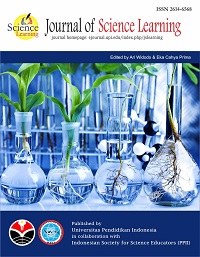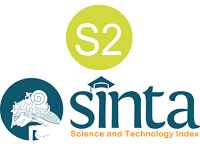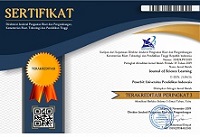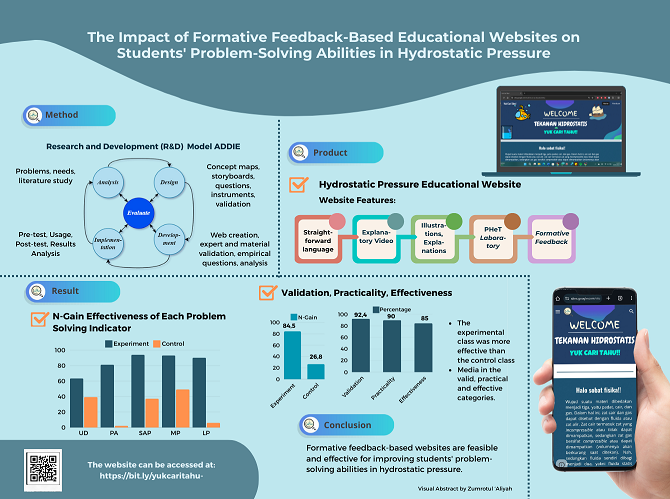
The Impact of Formative Feedback-Based Educational Websites on Students' Problem-Solving Abilities in Hydrostatic Pressure
Abstract
In the context of physics education, it is imperative that educators prioritize the development of students' problem-solving abilities. Given the interdisciplinary nature of physics and its relevance to everyday life, students must possess robust problem-solving skills. However, conventional and uninspiring learning approaches have been shown to diminish students' interest and proficiency in problem-solving. In response to this challenge, a website based on formative feedback has been developed to enhance students' problem-solving abilities in hydrostatic pressure. This research employed the research and development method with the ADDIE model, involving two classes, to assess the developed media's validity, practicality, and effectiveness. The website has been tested and proven valid, practical, and effective. This is based on the testing of the website on students with pre-test and post-test, which resulted in significant outcomes (p < 0.05), indicating a clear distinction between the control and experimental classes. Additionally, the N-gain scores in the experimental class showed that the website effectively enhances students' problem-solving skills. In contrast, the N-gain scores in the control class showed ineffective results. Therefore, the media is suitable for implementation in schools.
Keywords
Full Text:
Download PDFReferences
Azzahra, S., Khasanah, N. I., Kurniawan, D. A., Maison, M., Wibisono, G., Sari, D. P., & Nasution, O. S. M. (2022). Analisis Minat Belajar Peserta Didik dalam Pembelajaran Fisika Menggunakan Website sebagai Media Pembelajaran di SMAN 8 Tanjung Jabung Barat [Analysis of Students' Learning Interests in Physics Learning Using Websites as Learning Media at SMAN 8 Tanjung Jabung Barat]. JURNAL PENDIDIKAN MIPA, 12(2), 192–197. https://doi.org/10.37630/jpm.v12i2.557
Dick, W., & Carey, L. (2001). The Systematic Design of Instruction (5th ed.). Addison-Wesley Educational Publishers Inc.
Fajarianingtyas, D. A., & Hidayat, J. N. (2023). Pengembangan Media Pembelajaran Berbasis Web Biologi Dasar untuk Meningkatkan Kemampuan Pemecahan Masalah Mahasiswa IPA [Development of Web-Based Learning Media for Basic Biology to Improve Science Students' Problem-Solving Skills]. Jurnal Kiprah, 11(1), 12–20. https://doi.org/10.31629/kiprah.v11i1.5357
Fajarudin, M. F. (2023). Inkuiri Terbimbing Berbantuan Website Interaktif untuk Meningkatkan Penguasaan Konsep dan Kemampuan Pemecahan Masalah Siswa Kelas X pada Topik Listrik Arus Searah [Guided Inquiry Assisted by Interactive Website to Improve Concept Mastery and Problem Solving Skills of Grade X Students on Direct Current Electricity Topic]. Jurnal Sains dan Sistem Teknologi Informasi, 5(1), 47–54. https://doi.org/10.59811/sandi.v5i1.31
Finnegan, L. (2017). The impact of technology on the teaching and learning process. In Handbook of Research on Human Development in the Digital Age (pp. 235–257). https://doi.org/10.4018/978-1-5225-2838-8.ch011
Fuadia, L. A., Musbaiti, M., & Pramesti, S. L. D. (2023, July). Analisis Instrumen Asesmen Formatif dalam Meningkatkan Kemampuan Memecahkan Masalah Matematika Siswa [Analysis of Formative Assessment Instruments in Improving Students' Mathematical Problem Solving Ability]. In SANTIKA: Seminar Nasional Tadris Matematika (Vol. 3, pp. 315-327).
Global Stats. (2016). Mobile and tablet internet usage exceeds desktop for first time worldwide. Retrieved June 27, 2024, from StatCounter Global Stats website: https://gs.statcounter.com/press/mobile-and-tablet-internet-usage-exceeds-desktop-for-first-time-worldwide
Gunada, I. W., & Roswiani, Y. (2019). Analisis Tingkat Kemampuan Pemecahan Masalah Materi Fluida Statis Melalui Model Pembelajaran Problem Solving [Analysis of the Level of Problem Solving Ability in Static Fluid Material Through the Problem Solving Learning Model]. Jurnal Pijar MIPA, 14(1), 29–33. https://doi.org/10.29303/jpm.v14i1.989
Hamzah, A. (2019). Metode Penelitian dan Pengembangan [Research and Development Methods]. Literasi Nusantara.
Hidayat, F., & Nizar, M. (2021). Model Addie (Analysis, Design, Development, Implementation and Evaluation) Dalam Pembelajaran Pendidikan Agama Islam [Addie Model (Analysis, Design, Development, Implementation and Evaluation) in Islamic Religious Education Learning]. Jurnal Inovasi Pendidikan Agama Islam (JIPAI), 1(1), 28–38. https://doi.org/10.15575/jipai.v1i1.11042
Ismawati, I., Mutia, N., Fitriani, N., & Masturoh, S. (2021). Pengembangan Media Pembelajaran Fisika Berbasis Web Menggunakan Google Sites Pada Materi Gelombang Bunyi [Development of Web-Based Physics Learning Media Using Google Sites on Sound Wave Material]. Schrodinger Jurnal Ilmiah Mahasiswa Pendidikan Fisika, 2(2), 140–146. https://doi.org/10.30998/sch.v2i2.4348
Jamun, Y. M. (2018). Dampak Teknologi terhadap Pendidikan [Impact of Technology on Education]. Jurnal Pendidikan Dan Kebudayaan Missio, 10(1), 48–52. https://doi.org/10.36928/jpkm.v10i1.54
Januarifin, D., Parno, P., & Hidayat, A. (2017). Kesalahan Siswa SMA dalam Memecahkan Masalah Fluida Statis [High School Students' Mistakes in Solving Static Fluid Problems]. In Seminar Nasional Pendidikan IPA 2017 (Vol. 2).
Juniayanti, D., & Susila, I. K. D. (2022). Efektivitas Penggunaan Media PECS untuk Meningkatkan Kemampuan Berkomunikasi Anak Autis di SLB Negeri 1 Gianyar [The Effectiveness of Using PECS Media to Improve the Communication Skills of Autistic Children at SLB Negeri 1 Gianyar]. Jurnal Pendidikan Dan Konseling (JPDK), 4(2), 1-7.
Lestari, I. F. (2019). Pendekatan Science, Technology, Engineering, and Mathematics (STEM) untuk Meningkatkan Kemampuan Pemecahan Masalah Fisika Siswa pada Konsep Tekanan Hidrostatis [Science, Technology, Engineering, and Mathematics (STEM) Approach to Improve Students' Physics Problem Solving Ability on the Concept of Hydrostatic Pressure]. Jurnal Pendidikan UNIGA, 13(1), 215–221. https://doi.org/10.52434/jp.v13i1.831
Munti, N. Y. S., & Syaifuddin, D. A. (2020). Analisa Dampak Perkembangan Teknologi Informasi Dan Komunikasi Dalam Bidang Pendidikan [Analysis of the Impact of the Development of Information and Communication Technology in the Field of Education]. Jurnal Pendidikan Tambusai, 4(2), 1975–1805.
Nurfadilah, N., Putra, D. P., & Riskawati, R. (2021). Pembelajaran Daring Melalui Game Edukasi Quizizz Terhadap Hasil Belajar Fisika [Online Learning Through Educational Games Quizizz On Physics Learning Outcomes. Jurnal Pendidikan Fisika Dan Teknologi, 7(2), 182–189. https://doi.org/10.29303/jpft.v7i2.2870
Nurfalah, E. (2019). Optimalisasi E-Learning Berbasis Virtual Class dengan Google Classroom sebagai Media Pembelajaran Fisika [Optimizing Virtual Class-Based E-Learning with Google Classroom as a Physics Learning Media]. Physics Education Research Journal, 1(1), 46–55.
Nurjannah, E., Ayub, S., Doyan, A., & Sahidu, H. (2021). Pengembangan Perangkat Pembelajaran Model Inkuiri Terbimbing Berbantu Media PhET untuk Meningkatkan Kemampuan Pemecahan Masalah dan Keterampilan Generik Sains Fisika Peserta Didik [Development of Guided Inquiry Model Learning Tools Assisted by PhET Media to Improve Students' Problem Solving Abilities and Generic Physical Science Skills]. Jurnal Pendidikan, Sains, Geologi, dan Geofisika (GeoScienceEd Journal), 2(1). https://doi.org/10.29303/goescienceedu.v2i1.127
Peterson, C. (2003). Bringing ADDIE to life: Instructional design at its best—Learning & technology library (LearnTechLib). Journal of Educatioanal Multimedia and Hypermedia, 12(3), 227–241.
Popham, W. J. (1995). Classroom Assesment: What Teachers Need to Know. Allyn and Bacon.
Prani, A. I. E., Parno, P., & Hidayat, A. (2017). Penelitian Eksplanatori: Keterampilan Berpikir Kritis Siswa SMA Pada Materi Fluida Statis [Explanatory Research: Critical Thinking Skills of High School Students on Static Fluid Material]. In Seminar Nasional Pendidikan IPA 2017 (Vol. 2).
Purnamasari, I., Yuliati, L., & Diantoro, M. (2018). Teori, Penelitian, dan Pengembangan Kemampuan Pemecahan Masalah dan Model Mental Siswa pada Materi Fluida Statis [Theory, Research, and Development of Students' Problem Solving Ability and Mental Models on Static Fluid Material]. Jurnal Pendidikan, 3(10), 1299–1302.
Purwanto, R., Parno, P., & Yuliati, L. (2017). Eksplorasi Kemampuan Pemecahan Masalah Siswa SMA pada Materi Fluida Statis [Exploration of High School Students' Problem Solving Abilities in Static Fluid Material]. In Seminar Nasional Pendidikan IPA 2017 (Vol. 2).
Radjawane, M. M., Tinambunan, A., & Jono, S. (2022). Fisika untuk SMA/MA Kelas XI [Physics for Senior High School Grade XI]. Kementerian Pendidikan, Kebudayaan, Riset, dan Teknologi.
Rahim, F. R., Suherman, D., & Murtiani, M. (2019). Analisis Kompetensi Guru dalam Mempersiapkan Media Pembelajaran Berbasis Teknologi Informasi Era Revolusi Industri 4.0 [Analysis of Teacher Competence in Preparing Information Technology-Based Learning Media in the Industrial Revolution 4.0 Era]. Jurnal Eksakta Pendidikan (JEP), 3, 133. https://doi.org/10.24036/jep/vol3-iss2/367
Rahmawati, I. L., & Nugroho, H. S. E. (2015). Pengembangan Asesmen Formatif untuk Meningkatkan Kemampuan Self Regulation Siswa pada Teka Suhu dan Kalor [Development of Formative Assessment to Improve Students' Self-Regulation Skills in Temperature and Heat Puzzles]. UNNES Education Journal, 4(2).
Ramadhani, A. S., & Sulisworo, D. (2022). Peningkatan Motivasi dan Hasil Belajar Siswa pada Pembelajaran Fisika dengan Model ARCS [Improving Student Motivation and Learning Outcomes in Physics Learning with the ARCS Model]. Jurnal Genesis Indonesia, 1(02), 93–101. https://doi.org/10.56741/jgi.v1i02.94
Ramadhani, D. P., Nurhaliza, P., Mufit, F., & Festiyed. (2021). Analisis Penerapan Asesmen Formatif dalam Pembelajaran IPA dan Fisika: Literature Review [Analysis of the Application of Formative Assessment in Science and Physics Learning: Literature Review]. LENSA (Lentera Sains): Jurnal Pendidikan IPA, 11(2), 110–120. https://doi.org/10.24929/lensa.v11i2.172
Ringo, E. S., Kusairi, S., & Latifah, E. (2019). Profil Kemampuan Pemecahan Masalah Siswa SMA pada Materi Fluida Statis [Profile of High School Students' Problem Solving Ability in Static Fluid Material]. Jurnal Pendidikan: Teori, Penelitian, dan Pengembangan, 4(2), 178–187.
Sari, I. P. M., Jatmiko, B., & Suprapto, N. (2023). Students' Physics Problem-Solving Skills in Daily Life Context: Between Confession and Fact. Jurnal Penelitian Pendidikan IPA, 9(1), 231–241. https://doi.org/10.29303/jppipa.v9i1.2561
Septian, A., Ramadhanty, C. L., Darhim, D., & Prabawanto, S. (2021, March). Mathematical problem solving ability and student interest in learning using Google Classroom. In Prosiding International Conference on Education of Suryakancana (Vol. 1, No. 1, pp. 155-161).
Suyoso, S., & Nurohman, S. (2014). Pengembangan Modul Elektronik Berbasis Web Sebagai Media Pembelajaran Fisika [Development of Web-Based Electronic Modules as Physics Learning Media]. Jurnal Kependidikan Penelitian Inovasi Pembelajaran, 44(1). https://doi.org/10.21831/jk.v44i1.2193
Vo, M. K., & Sharp, J. C. (2019). Design, Development, and Content Creation for an Open Education Physics Website for MRT Education. Journal of Medical Imaging and Radiation Sciences, 50(2), 212–219. https://doi.org/10.1016/j.jmir.2019.03.180
Wahyuni, S., Djudin, T., & Oktavianty, E. (2018). Integrasi Remediasi Miskonsepsi Siswa Menggunakan Model Problem Based Learning Dalam Pembelajaran Fluida Statis di SMA [Integration of Student Misconception Remediation Using Problem Based Learning Model in Static Fluid Learning in High School]. Jurnal Pendidikan dan Pembelajaran Khatulistiwa (JPPK), 7(7).
Wangchuk, D., Wangdi, D., Tshomo, S., & Zangmo, J. (2023). Exploring Students’ Perceived Difficulties of Learning Physics. Educational Innovation and Practice, 6. https://doi.org/10.17102/eip.6.2023.03
Wicaksono, I., Aprilian, Ir., & Supraptiningsih, L. K. (2022). Penerapan Asesmen Formatif Pembelajaran Fisika dengan Kuis Game Edukasi dan Penilaian Diri Siswa SMA [Implementation of Formative Assessment of Physics Learning with Educational Game Quizzes and Self-Assessment of High School Students]. Education Journal : Journal Education Research and Development, 6(2), 139–150.
DOI: https://doi.org/10.17509/jsl.v8i1.72618
Refbacks
- There are currently no refbacks.
Copyright (c) 2025 Zumrotul ‘Aliyah, Sunaryono Sunaryono, Khusaini Khusaini, Bakhrul Rizky Kurniawan

This work is licensed under a Creative Commons Attribution-ShareAlike 4.0 International License.
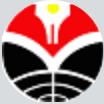

Jl. Dr. Setiabudhi 229 Bandung 40154, West Java, Indonesia






